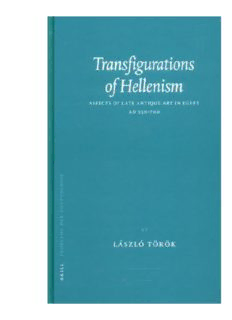
Transfigurations of Hellenism: Aspects of Late Antique Art in Egypt, AD 250-700 (Probleme der Ägyptologie) PDF
Preview Transfigurations of Hellenism: Aspects of Late Antique Art in Egypt, AD 250-700 (Probleme der Ägyptologie)
fi Trans gurations of Hellenism Probleme der Ägyptologie Herausgegeben von Wolfgang Schenkel und Antonio Loprieno 23. Band fi Trans gurations of Hellenism Aspects of Late Antique Art in Egypt AD 250–700 by László Török BRILL LEIDEN•BOSTON 2005 This book is printed on acid-free paper. Library of Congress Cataloging-in-Publication Data Török, László, 1941– Transfigurations of Hellenism : aspects of late antique art in Egypt, A.D. 250–700/ by László Török. p. cm. — (Probleme der Ägyptologie, ISSN 0169–9601; 23. Bd.) Includes bibliographical references and indexes. ISBN 90–04–14332–7 (hardback : alk. paper) 1. Art, Coptic. 2. Art, Hellenistic—Egypt. I. Title. II. Series. N7382.T67 2005 709’.32’09015—dc22 2004062868 ISSN 0169–9601 ISBN 90 04 143327 © Copyright 2005 by Koninklijke Brill NV, Leiden, The Netherlands. Koninklijke Brill NV incorporates the imprints Brill Academic Publishers, Martinus Nijhoff Publishers and VSP. All rights reserved. No part of this publication may be reproduced, translated, stored in a retrieval system, or transmitted in any form or by any means, electronic, mechanical, photocopying, recording or otherwise, without prior written permission from the publisher. Authorization to photocopy items for internal or personal use is granted by Brill provided that the appropriate fees are paid directly to The Copyright Clearance Center, 222 Rosewood Drive, Suite 910, Danvers, MA 01923, USA. Fees are subject to change. printed in the netherlands * For Tomas Hägg • Bente Kiilerich • Per Jonas Nordhagen Hjalmar Torp the Bergen masters of Late Antiquity with friendship and gratitude * CONTENTS List of figures ............................................................................ xi List of plates .............................................................................. xix Acknowledgements .................................................................... xxiii A note on the terminology ...................................................... xxv I. Introduction: A visit to the Coptic Museum in Old Cairo ............................................................................ 1 II. Images of late antique Egypt in twentieth-century art history ........................................................................ 9 1. The Ahnas pitfall ............................................................ 9 2. The myth of anti-Hellenism .......................................... 12 3. Pharaonic revival: myth and reality .............................. 17 4. The myth of Volkskunst and the contribution of forgery to Coptic art history ........................................ 20 5. From Ernst Kitzinger’s “Notes on Early Coptic Sculpture” to Hjalmar Torp’s “Leda Christiana” ...... 31 III. On methods ........................................................................ 37 1. Function, chronology, and style .................................... 37 2. Chronology and the stratification of artistic production ........................................................................ 40 3. The limits of the investigation ...................................... 44 IV. History, society, and art in late Roman and early Byzantine Egypt .................................................................. 51 1. Images of social identity ................................................ 51 2. History and society in late antique and early Byzantine Egypt .............................................................. 58 2.1. The conquest of Ptolemaic Egypt ........................ 58 2.2. Roman Egypt from Augustus to the late third century .................................................................... 64 2.3. Late Roman Egypt ................................................ 73 2.4. Christians and polytheists ...................................... 86 2.5. Early Byzantine Egypt ............................................ 97 viii contents V. Continuity and change 1: The survival of forms of Alexandrian Hellenistic architecture .............................. 113 1. The limits of the evidence ........................................ 113 2. Hellenistic and late antique illusionism: the niche pediments and their architectural and cult context 115 3. Further glimpses of late antique Alexandria ............ 130 VI. Continuity and change 2: New patterns of monumentality ................................................................ 139 1. The imperial cult sanctuary of the Tetrarchs in the Amûn temple of Luxor ........................................ 139 2. Modernity and archaizing in Shenoute’s “White Monastery” at Sohag .................................... 153 3. The episcopal complex at Hermopolis Magna ........ 165 4. Uses of the past .......................................................... 178 VII. Images for mortuary display .......................................... 183 1. Sculptors, workshops and modes of representation 183 1.1. Porphyry sculpture and the workshop at Heracleopolis Magna .......................................... 183 1.2. The masters of acanthus foliage ........................ 193 1.3. Sculptors’ workshops at Oxyrhynchos in the fourth and early fifth centuries .......................... 205 1.4. The end of late antique illusionism in architectural sculpture ........................................ 211 VIII. Images of the good life: display and style .................... 217 1. Iconography of wealth ................................................ 217 2. Styles of wealth .......................................................... 221 2.1. Praise to the glorious house. The tapestry of the Erotes and its circle .................................... 221 2.2. From narrative to symbol. The great Dionysiac tapestry in Riggisberg ........................ 233 3. Ornaments for the patrician house and the church .......................................................................... 236 4. Images and ideals. Creating an Egyptian style ........ 245 5. Decline or transformation? Art for the less wealthy ........................................................................ 259 contents ix IX. The Christianization of art in late antique Egypt .......... 269 1. Classical tradition: from pagan to Christian ................ 269 1.1. Double readings ...................................................... 269 1.2. Creating new narratives ........................................ 275 1.3. Portraying the holy ................................................ 288 2. Ecclesiastical display and delight in the good things .............................................................................. 302 2.1. The city of St Menas ............................................ 302 2.2. Sculpture in the early Byzantine period .............. 310 2.3. Images for higher contemplation .......................... 334 Epilogue: Perennial Hellenism? ................................................ 351 Abbreviations .............................................................................. 359 Index of names .......................................................................... 385 Index of places and monuments .............................................. 390 Museum index .......................................................................... 395 Illustrations ................................................................................ 403
Description: